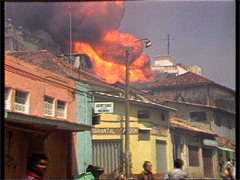from Colombo to Jaffna
by Ananth Palakidnar, Jaffna Post, July 25, 2025
From the time the land mine explosion took place on July 23, 1983, the Eelanadu regional newspaper, where I was a sub editor, became active on covering every incident in Jaffna and Colombo, as well as India’s stance with regard to the July ’83 communal unrest.

Black July 1983 / Young Asia TV. Source: Sangam
Energetic news editor late K. G. Mahadeva was all out to collect the stories from Jaffna, Colombo and India supported by Eelanadu’s correspondents Mahalingasivam and E. Kanthaswamy in Colombo. Both of them did a good job despite the problems they faced in Colombo following the intensity of the communal unrest.
News editor late Mahadeva on the directive of Editor in Chief late N. Sabaratnam, tasked me with covering the arrival of the first ship carrying the July riots refugees at the Kankasanthurai (KKS) Harbor.
The Colombo office had informed us that the cargo ship carrying the refugees had left Colombo harbor and it was expected to reach the KKS Harbor in four days. The office vehicle which was a Morris Minor car was given to me and to my office photographer A. Thevaraja.
The ship with the refugees which left Colombo on July 29, arrived on August first. My photographer Thevaraja and I waited at the KKS Harbor beach where we spotted the ship which was preparing to disembark the passengers into small boats to reach the shores.
Thevaraja prepared the camera to take the photo of the first refugee stepping on the KKS shores.
The first boat packed with refugees from the big ship was heading towards the KKS beach and before it reached the shores, a young man in trousers with a shoulder bag jumped out of the boat and walked towards the shores. Thevaraja went near him and took pictures of him. He was crying and shouted, “We have lost everything. This is the only bag I have left with a set of clothes.” He was kicking the water with his legs at us in anger.
Realising his state of mind, we approached him and told him that we were from the press. He started talking to us describing how he had lost everything he owned and only possessed the bag he was carrying. He was the first person to tell us about the situation in Colombo and mentioned that that there was nothing of the Tamils left behind in Colombo.
According to Tamil politician M. A. Sumanthiran, he was at that time a student at Royal College and he too was in that first ship from Colombo with his parents and siblings.
The Government Agent of Jaffna Thevanesan Nesiah supported by his senior administrative officer S. Sivathasan had looked into the immediate requirements of the refugees arriving from Colombo.
Following the arrival of the first ship carrying the riot victims from Colombo, the Indian Government led by Indira Gandhi showed its concern towards the Tamil refugees devastated by the riots. She sent her Foreign Minister Narasimha Rao to Colombo and directed him to report to her on the whole situation following the riots.
Following Narasimha Rao’s visit to Colombo, Gandhi had sent India’s luxury cruise liner M V Chidambaram to transport all Tamil refugees from Colombo to Jaffna.
It was in the luxurious cruise liner M V Chidambaram that Eelanadu Colombo correspondent E. Kanthaswamy also arrived in Jaffna together with hundreds of Tamil refugees. He was very impressed with the hospitality extended to the Tamil refugees on board the ship
According to Kanthaswamy, the crew members had looked after them well and plenty of food items with other facilities were offered to the refugees in abundance on the ship. Kanthaswamy even wrote about his experience on his voyage to Jaffna from Colombo.
In the meantime, following the Thirunelveli land mine explosion in Jaffna which had killed thirteen soldiers, army personnel from Palaly army camp had arrived in trucks to the site of the explosion and went on attacking houses, shops and even shooting at the people on sight.
Around 60 people died due to the reckless behavior of the army personnel who came from Palaly. Some of the senior officers even later said that they couldn’t control their men and they were not obeying their orders.
Political analysts commenting on President J. R. Jayewardene’s attitude towards the July ’83 disturbances said that if he had flexed his muscles and controlled the rioters at the very beginning he could have not only prevented the communal riots, but he could have even submerged the North and East civil strife before it turned into a bloodiest armed conflict which continued for three decades.